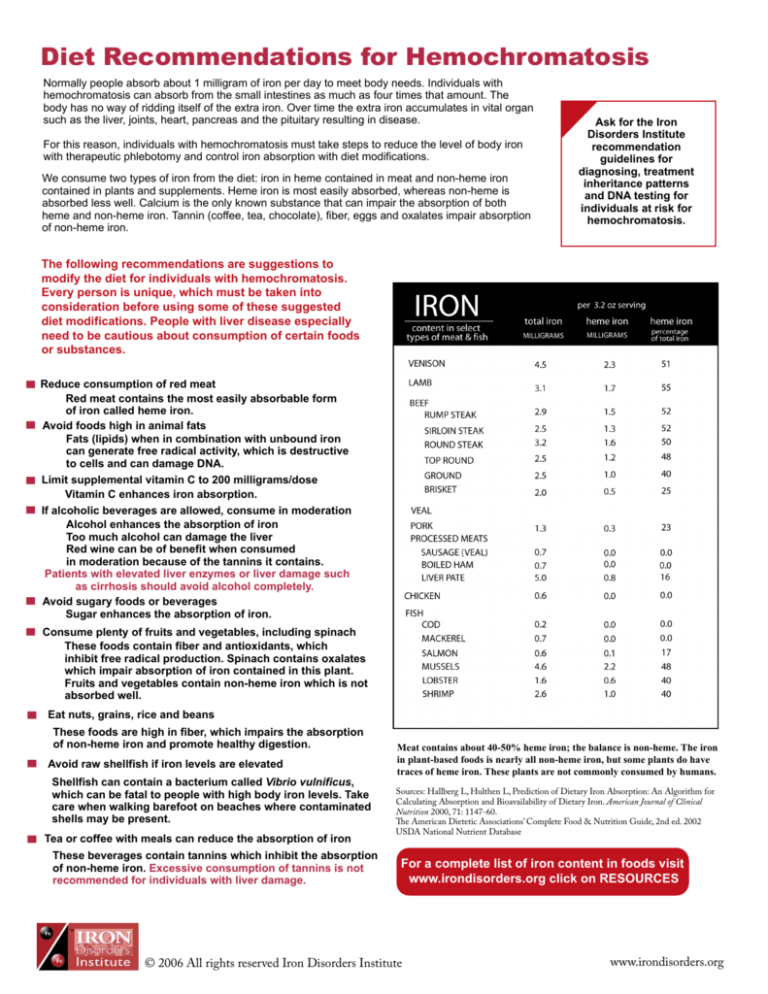
Diet Recommendations for Hemochromatosis
Normally people absorb about 1 milligram of iron per day to meet body needs. Individuals with
hemochromatosis can absorb from the small intestines as much as four times that amount. The
body has no way of ridding itself of the extra iron. Over time the extra iron accumulates in vital organ
such as the liver, joints, heart, pancreas and the pituitary resulting in disease.
For this reason, individuals with hemochromatosis must take steps to reduce the level of body iron
with therapeutic phlebotomy and control iron absorption with diet modifications.
We consume two types of iron from the diet: iron in heme contained in meat and non-heme iron
contained in plants and supplements. Heme iron is most easily absorbed, whereas non-heme is
absorbed less well. Calcium is the only known substance that can impair the absorption of both
heme and non-heme iron. Tannin (coffee, tea, chocolate), fiber, eggs and oxalates impair absorption
of non-heme iron.
Ask for the Iron
Disorders Institute
recommendation
guidelines for
diagnosing, treatment
inheritance patterns
and DNA testing for
individuals at risk for
hemochromatosis.
The following recommendations are suggestions to
modify the diet for individuals with hemochromatosis.
Every person is unique, which must be taken into
consideration before using some of these suggested
diet modifications. People with liver disease especially
need to be cautious about consumption of certain foods
or substances.
Reduce consumption of red meat
Red meat contains the most easily absorbable form
of iron called heme iron.
Avoid foods high in animal fats
Fats (lipids) when in combination with unbound iron
can generate free radical activity, which is destructive
to cells and can damage DNA.
Limit supplemental vitamin C to 200 milligrams/dose
Vitamin C enhances iron absorption.
If alcoholic beverages are allowed, consume in moderation
Alcohol enhances the absorption of iron
Too much alcohol can damage the liver
Red wine can be of benefit when consumed
in moderation because of the tannins it contains.
Patients with elevated liver enzymes or liver damage such
as cirrhosis should avoid alcohol completely.
Avoid sugary foods or beverages
Sugar enhances the absorption of iron.
heme
Consume plenty of fruits and vegetables, including spinach
These foods contain fiber and antioxidants, which
inhibit free radical production. Spinach contains oxalates
which impair absorption of iron contained in this plant.
Fruits and vegetables contain non-heme iron which is not
absorbed well.
Eat nuts, grains, rice and beans
These foods are high in fiber, which impairs the absorption
of non-heme iron and promote healthy digestion.
Avoid raw shellfish if iron levels are elevated
Shellfish can contain a bacterium called Vibrio vulnificus,
which can be fatal to people with high body iron levels. Take
care when walking barefoot on beaches where contaminated
shells may be present.
Tea or coffee with meals can reduce the absorption of iron
These beverages contain tannins which inhibit the absorption
of non-heme iron. Excessive consumption of tannins is not
recommended for individuals with liver damage.
Meat contains about 40-50% heme iron; the balance is non-heme. The iron
in plant-based foods is nearly all non-heme iron, but some plants do have
traces of heme iron. These plants are not commonly consumed by humans.
Sources: Hallberg L, Hulthen L, Prediction of Dietary Iron Absorption: An Algorithm for
Calculating Absorption and Bioavailability of Dietary Iron. American Journal of Clinical
Nutrition 2000, 71: 1147-60.
The American Dietetic Associations’ Complete Food & Nutrition Guide, 2nd ed. 2002
USDA National Nutrient Database
For a complete list of iron content in foods visit
www.irondisorders.org click on RESOURCES
© 2006 All rights reserved Iron Disorders Institute
www.irondisorders.org







